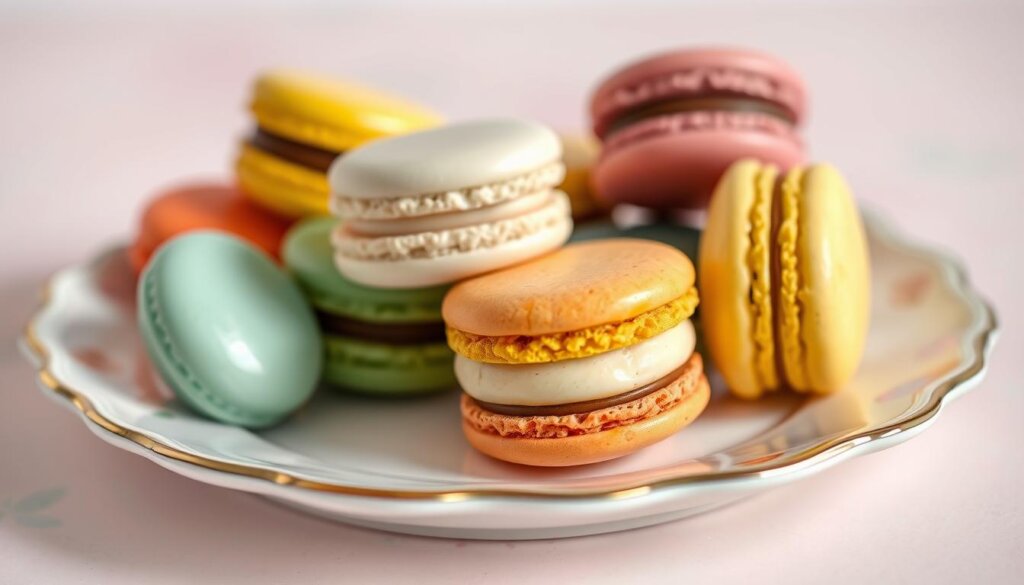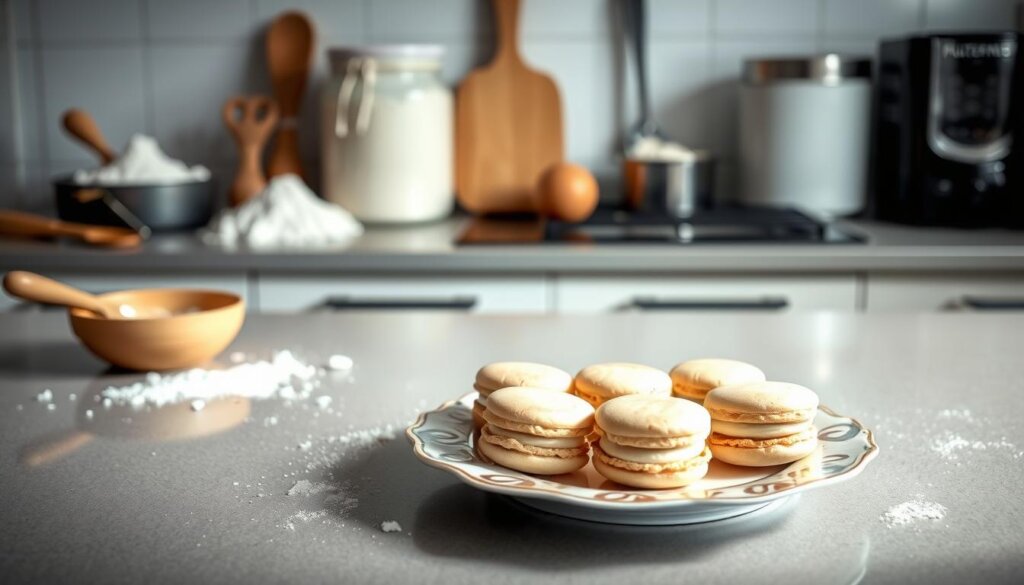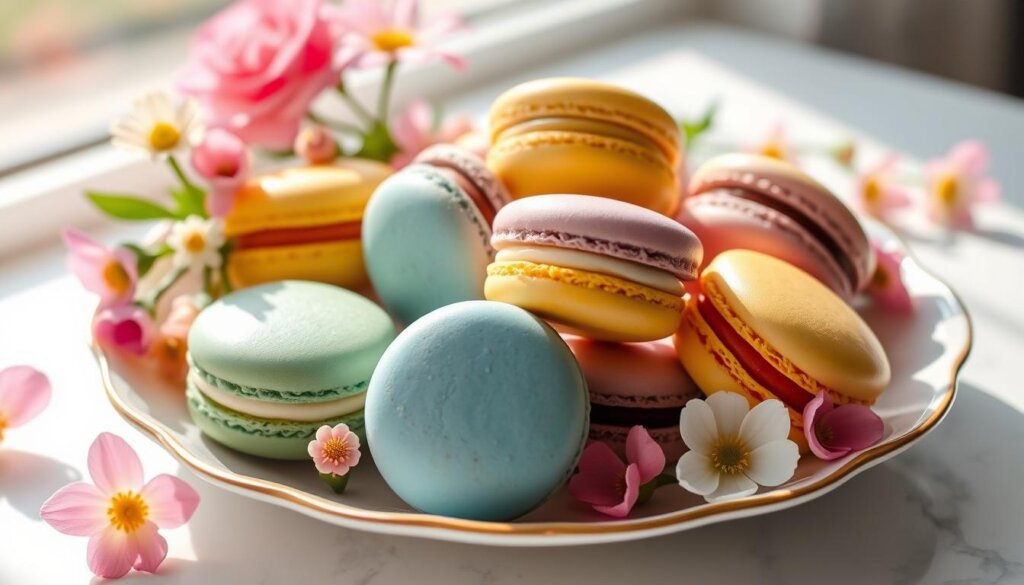Are macarons gluten-free? This is a common question when exploring gluten-free desserts. French macarons have become very popular. They are made with almond flour, which is gluten-free.
This makes them a good choice for those with dietary restrictions. Each macaron has about 80 calories and is low in carbs. This makes them appealing to health-conscious people.
Looking for gluten-free desserts? Check out gluten-free dessert guides. They can teach you about French macarons’ ingredients and how to make them. Macarons come in many flavors, including gluten-free and dairy-free ones. They are perfect for those who want to enjoy tasty gluten-free treats.
If you’re looking for more gluten-free dessert inspiration, check out our Gluten-Free Creme Brulee or learn how to make Easy Gluten-Free Cookie Dough. For even more options, discover The Best Homemade Gluten-Free Cinnamon Rolls. With their low-carb profile and variety of flavors, macarons are the perfect gluten-free treat for any occasion.
Table of contents
What Are Traditional French Macarons?
French macarons are known for their delicate, chewy texture and variety of fillings. They have a long history in France, starting in the early 1900s. These treats are made with almond flour, egg whites, sugar, and confectioners’ sugar.
Almond flour is crucial for macarons to be glutenless. It adds structure and flavor. With the right ingredients, you can make many flavors, from raspberry and chocolate to lemon and rose petal.
The History of French Macarons
French macarons have been a favorite in French bakeries for centuries. Famous places like Ladurée have been making them for generations. Today, you can find them in many flavors, from classic to modern.
Basic Macaron Ingredients
To make traditional French macarons, you need almond flour, egg whites, sugar, and confectioners’ sugar. Using high-quality ingredients is important for the best taste and texture. Brands like Trader Joe’s and Bob’s Red Mill are good choices for almond flour.
Different Types of Macarons
French macarons come in a wide range of flavors and fillings. You can find everything from classic raspberry and chocolate to unique matcha and pistachio. You can also try different fillings like buttercream and fruit curds for new tastes.
Are Macarons Gluten Free?
Exploring gluten-free macarons means knowing their ingredients. Almond flour, a key part of macaron shells, has no gluten. This makes it great for those with gluten issues.
Traditional macarons use almond flour, egg whites, and sugars. This makes them a good gluten-free option. But, some flavors might have gluten, like cookie butter. So, always check the flavor to make sure they’re gluten-free. Celiac-friendly desserts like macarons are safe for those with coeliac disease.
Almond flour is low in carbs and rich in healthy fats and fiber. When buying gluten-free macarons, choose brands that keep their glutenless kitchen. This way, you can enjoy glutenless macarons without worry.

- Choose traditional flavors to minimize the risk of gluten contamination
- Opt for brands that guarantee a gluten-free environment in their kitchen
- Always check the ingredients and labels to ensure the macarons are glutenless.
Understanding Cross-Contamination Risks in Macaron Production
Gluten-free baking is all about avoiding cross-contamination. If you’re thinking about trying macarons, knowing the risks is key. This is crucial for those with gluten intolerance or sensitivity, as even a little gluten can be harmful.
In big bakeries, gluten-free and gluten products are often made together. This raises the risk of cross-contamination. To lower this risk, bakeries follow strict gluten-free rules. They use separate tools, storage, and handling methods. Some even have special gluten-free zones or tools.
Commercial Bakery Practices
Big bakeries must make sure their gluten-free items are safe. They clean well, train staff, and follow gluten-free rules. Some even get certified by groups like the Gluten-Free Certification Organization (GFCO) to show they’re serious about safety.
Home Baking Considerations
Home bakers need to keep things gluten-free when making macarons. This means using only gluten-free tools and storing ingredients separately. It’s also important to watch out for cross-contamination, like shared spaces or tools that have touched gluten.

Certification and Labeling
When buying macarons, look for the Gluten-Free Certification Organization (GFCO) stamp. It means the product is safe for gluten-free diets. Also, check the label for any gluten risks, like shared equipment. By being careful, you can enjoy gluten-free macarons safely.
Where to Buy Safe Gluten-Free Macarons
Looking for gluten-free bakeries with tasty treats? Many bakeries now have certified glutenless macarons for those with dietary needs. This is because more people want gluten-free options.
Places like California, Colorado, Michigan, Kentucky, New Jersey, and New York have great spots. Here, you can find glutenless bakeries with vegan macarons and other safe treats. For example, Joy and Sweets in Culver City, California, is famous for its cupcakes, cakes, and certified glutenless macarons.
Here are some reliable places for gluten-free macarons:
- Le Macaron French Pastries focuses on quality ingredients for the best gluten-free macaron experience.
- VEGAN MACARON BAKERY in Los Angeles delivers nationwide and has seasonal flavors.
- Glacé by NoGlu in New York offers ice cream and certified gluten-free macaron ice cream sandwiches.

Buying from trusted gluten-free bakeries lets you enjoy your favorite treats safely. Always check for certifications and ask about cross-contamination to stay safe.
Conclusion: Enjoying Macarons on a Gluten-Free Diet
Gluten-free macarons can be a tasty treat for those on a glutenless lifestyle. By checking ingredients and how they’re made, you can enjoy these French treats safely. It’s key to buy from a reliable bakery or make them yourself to avoid gluten contamination.
Exploring macaron alternatives can add fun to your gluten-free desserts. You can try shells made with coconut or hazelnut flour for more variety. With some research and care, you can enjoy the delicious taste and texture of macarons while sticking to your glutenless diet.
FAQ
What are traditional French macarons?
French macarons are delicate cookies. They are made with almond flour. Known for their domed shape and light texture.
What is the history of French macarons?
Macarons started in early 20th century France. Famous Parisian patisseries like Ladurée helped make them popular.
What are the basic ingredients in macarons?
Macarons need almond flour, powdered sugar, and egg whites. Sometimes, food coloring or flavorings are added.
What are the different types of macarons?
There are many flavors of macarons. You can find vanilla, chocolate, and even salted caramel, green tea, and fruit flavors.
Are macarons gluten-free?
Yes, traditional French macarons are glutenless. They are made with almond flour, making them safe for those on a gluten-free diet.
What are the potential risks of cross-contamination in macaron production?
Bakers must be careful to avoid cross-contamination. This means using separate areas and following strict cleaning rules. It’s also important to have proper certification and labeling.
Where can I find safe, gluten-free macarons?
Look for bakeries that specialize in gluten-free items. They have strict rules to avoid cross-contamination. Online gluten-free bakeries are also a good option.
Are macarons gluten-free at Costco?
Costco macarons are often without gluten, but you should verify the label for cross-contamination warnings or specific allergens.
Are macarons in Paris gluten-free?
Traditional Parisian macarons are typically glutenless as they’re made with almond flour, but cross-contamination in bakeries is possible. Always confirm with the bakery.
Are birthday cake macarons gluten-free?
Birthday cake macarons can be glutenless, depending on the ingredients used for the flavoring. Check labels or inquire with the seller for assurance.





